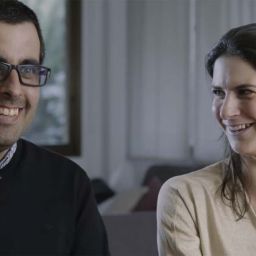For 70% of executives, the number one stress is how to raise productivity. Christina Janzer knows exactly what will work – and exactly what won’t (and it’s something we guarantee a whole lot of you are doing).
Christina is Head of Research and Analytics for productivity platform Slack. Armed with insights from Slack’s global knowledge worker research – a survey of 10,000 desk workers – she says she wants to make work a little better every day.
Professor Marta Elvira is Professor of Strategic Management and Managing People in Organisations at IESE Business School, one of the world’s best business schools – ranked No.1 in the world for six years running by the Financial Times.
This is Real leadership podcast: Every episode, a business leader shares human stories and hard truths from their career. And an expert turns those stories into lessons we can all learn.
In this episode, Christina and Marta discuss:
- What metrics do you need to know to change now
- How to build a culture of trust
- How to break down siloes between departments and teams
- How to stay ahead in a rapidly changing world
Listen to this podcast:
Fore more content like this visit the Real Leadership website.
Podcast transcription:
Adam:
Hello and welcome to This is Real Leadership. Where, every episode, a proven business leader shares human stories and hard truths from across their career. And an expert turns those words into lessons we can all learn.
In this episode, those lessons are about trust and communication, with one goal: to make your workplace, well, a better place to work.
I’m Adam Burns. I have been talking and writing about business leadership for over 25 years and still, every day’s a school day. Which is why, in this podcast, I’m joined by a distinguished professor from IESE, one of the world’s best business schools, ranked number 1 in the world for six years running.
They’ll also be talking with our guest. And then, just with me. Offering their expert analysis of the conversation, as I ask, “What are the real leadership lessons here?”.
So, what can we learn in the next 30 minutes. Let’s find out with our expert, Professor Marta Elvira. Marta, you are Professor of Strategic Management and Managing People in Organizations at IESE. The Irish playwright George Bernard Shaw is widely quoted as saying, “The single biggest problem with communication is the illusion that it has taken place.” Shaw died in 1950. Marta, why is this still true?
Marta Elvira:
I suppose, because “Communication, communication, communication” is the message that we hear from the experts. But also, within organizations, we take it for granted. Because, I think, with increased diversity in the workplace comes different ways of expressing and understanding messages. And therefore, this will be a constant in a workplace that is increasingly diverse. We need to work with people that may have been educated in different systems, who are used to different cultures, and who express messages differently. So, learning to understand the real message takes time, and that’s not going to go away. And distance, or flexible working, is not facilitating that. Technology could facilitate it, but we cannot assume this is happening. So, yes, the message is as relevant as it was over 70 years ago, I guess. And we are never done with this topic, which bodes very well for organizational communication experts.
Adam:
Which brings us very nicely on to this week’s guest. Christina Janzer is Head of Research and Analytics for productivity platform Slack. Armed with insights from Slack’s Global Knowledge Worker research, a survey of 10,000 desk workers, Christina says she wants to make work a little better every day.
But how? We continue to experience seismic shifts in the world of work: the pandemic, economic uncertainty, new and deeply transformative technologies. We asked Christina how these sorts of things are showing up in her research. And, if we want to make work better, where should we start?
—
Christina Janzer:
So, as you can imagine, work has changed dramatically over the last few years. We first saw, with the pandemic, people changing where and when they work. And what we’re seeing now is that there’s a huge focus on productivity. What we’re seeing is that executives are really stressed about squeezing more productivity out of their teams. I think, for something like 70% of executives, their number one concern is, “How do we get our employees to be more productive?” But what’s really interesting is that they’re thinking about productivity in, what I would consider, a very backwards way. They’re really focused on tracking what we call activity metrics. So, how many hours a day are people working? How many emails are they sending? Things like that. And what that’s doing is causing employees to focus on performative work. How can I appear productive? How can I make sure that I’m doing things that prove to my boss that I’m working? And the thing is, that doesn’t actually make people more productive. So, we’re focused on the wrong things. And I think there’s a huge opportunity for executives to shift their thinking. Meaning, let’s not focus on the number of hours that people are working. Let’s not focus on emails. Let’s track outputs. Let’s not track inputs. Let’s really get to the bottom of what we can do to improve productivity. And what we found to be the number one driver of productivity is trust. So, there’s a big opportunity for us to really think about, “How can we rebuild a culture of trust in the workplace?” Because that’s what’s going to ultimately drive productivity.
Adam:
Are we seeing then, in effect, a form of digital presenteeism?
Christina Janzer:
100%. I think we’re all still getting used to this new way of working. I think managers are really struggling. This is something that we’ve seen over the last few years of research that we’ve done. Managers are struggling, because their jobs completely shifted, and they don’t have the tools to figure out, “How do I make sure that my team is productive? If I don’t see people every day, how do I know that the work is happening?” And I think it’s easy for them to think about, again, activity metrics and say, “Well, if I at least see that there are a lot of emails being sent, then maybe I can feel good that work is happening”.
Marta Elvira:
I thought your headline for the research was quite daring. I mean, trust is the key driver of productivity. And productivity has been the outcome of choice for management research for over a century, right? It’s like the holy grail that everyone is looking for. It’s very interesting. You mentioned that the metrics have changed according to the way work is changing. So, I was curious as to why you think that it is trust, really, that is driving productivity, relative to the many other variables that go into work?
Christina Janzer:
Yeah, it’s a great question, and it’s something that we’ve thought a lot about. I think that, when you feel trusted, the door opens for you to be more creative. It opens for you to be more innovative. And it opens for you to really come up with new solutions. What we see in the research is that people who feel trusted are two times more productive. I think you can imagine that, when you have that trust, again, you feel like you’re able to take risks, and you feel like you’re able to try new things. We also find that, when you feel trusted, you’re so much more likely to go above and beyond. The other thing we know is that people who feel trusted are much more likely to stay with their company. If you don’t feel trusted, you’re twice as likely to just leave, and find a new job.
Marta Elvira:
And, there is a bit of a balance to be struck, right? Because, in reality, I’m not sure that putting in more work actually equates to being more productive. So, there is a trick where leaders need to also evaluate what productive work is. But, we’ve already been through that. I was also curious about how you tie that trust to flexible work?
Christina Janzer:
So, yes, I’ll talk about flexible work in a second. I love the point that you just made. Because I don’t think the point here is to just get more and more out of our people. I think that there’s this risk that, if you enable people, or if you trust people, they’ll be more productive, and then they’ll just do more and more. I don’t think that’s the point here. I think we want to inspire people to come up with better ways of doing things, and more creative ways…
Marta Elvira:
Exactly.
Christina Janzer:
…of doing things. Not so that they can be 10 times more productive. Because I think it’s important to understand the key relationship between being well and doing well, and being good and doing good work. Employee experience is so important to pay attention to. And I think that we sometimes think of this as being at odds with productivity. But, if we take care of our employees, if we focus on their mental and physical wellbeing, if we trust them and nurture them, they’re going to do amazing work. And the point of that is not so that they can do 10 times more. I do think that’s a really important point. So, the question you asked was about the relationship between trust and flexibility?
Marta Elvira:
Correct.
Christina Janzer:
- So, what we know from our research is that there are many benefits of flexibility. And we also know that the future of work is hybrid. Not for everyone, but for many companies. People are figuring out what the right sort of hybrid model is, or the right flexible model. And we see that there’s a really important connection between flexibility and productivity. So, when people have schedule flexibility, that leads to greater productivity. The reason for that is, if you have more flexibility in your schedule, maybe to work when it’s best for you, or to carve out time to have that really deep, focused work, you’re going be more productive, right? Because you’re going to have that time to really focus and get your work done. If you’re just, sort of, 9 to 5, back-to-back meetings, it’s much harder to be productive. So, we see a really important relationship between trust and flexibility.
—
Real talk (voice and music)
—
So, boosting productivity is the holy grail for 70% of executives. And the future of work, for most, not all, is hybrid, with schedule flexibility playing a big role in boosting productivity. So, problem solved! Well, no. A lot of executives are not ready for hybrid, because they can’t figure out whether or not people with flexible schedules, who aren’t at work, are working. Which leads to the wrong things being measured. And now workers don’t feel trusted, so productivity is down. And executive stress levels are up.
But it’s this trust that is the key for Christina. And Marta wanted to know how it’s grown, and where it begins.
—
Marta Elvira:
I’d love to hear how you foster that listening, and that transparency. Getting people to lower the guard which they so commonly have up in organizations, for fear of retributions or negative evaluations beyond good performance.
Christina Janzer:
You know, when I think about how I spend my time as a leader… Many leaders spend so much time interviewing, hiring and finding the right people to come and join their company. Right? That takes a lot of time, and you put a lot of thought into who you are trying to hire. Making sure that you have a diverse panel. It’s a huge task. And it’s so interesting to me that we spend so much time hiring the right person, but then we start with zero trust. And so, my philosophy as a leader is, when somebody first joins my team, I 100% trust them. That’s how they start. Our relationship starts with 100% trust. Of course, they might lose that trust over time, but they probably won’t, if I did a good job hiring. What we see in our research is that, so often, people don’t even have access to the information they need to do their job. It’s like they have to earn it over time. And that doesn’t make sense. We should be trusting people from the start, and giving them all the tools and all the information that they need in order to do a good job. So, that’s just one really small thing that I think is important. But then, the other thing I was going to say is, there’s a huge role for us to play as leaders by setting the example. Setting the tone, being vulnerable. I talk about the fact that I have kids and that I have other priorities, and that I take a break to volunteer, or I do whatever it is that I’m doing outside of work. And I think it’s really good for leaders to set that tone. Similarly, somebody at the company who’s on the executive team, who’s a male, he’s doing a really great job setting the example by taking paternity leave. And saying, “I’m going take the whole thing. This is what it’s going to look like. I’m going to celebrate that”. Because, believe it or not, in America, that’s not always the case. So, I think there’s a big opportunity for leaders to set the tone. And, in terms of what our research tells us, transparency really builds trust. When you look at companies that are more transparent, you see that they have higher trust. And when I say transparency, what I mean is really important. It’s something that you said, Marta: it’s a two-way street. So, it’s leadership sharing with employees what’s top of mind, what’s going on with the company, what some of the decisions are that we’re grappling with, and how strategy is shifting. But it’s also the other way around; listening to employees and understanding what they are struggling with, understanding how they are feeling and what’s getting in the way of them doing the best work of their careers. And, most importantly, once you hear from them, say it back to them. This is what we heard. And actually make progress on improving. I think we often hear that people do the survey, but then they don’t do anything with the data. So that’s definitely something that we pay really close attention to. But creating those systems for that two-way feedback is so, so important. And I think, if we go back to what we were talking about, leadership looks very different now. Training leaders to be great communicators, and to be great at this sort of transparent two-way communication, is so important.
Marta Elvira:
And, if I may ask, would you have an example you could share of one of these responses to the employees concerned? Something you’ve put into practice because of that two-way feedback?
Christina Janzer:
Yeah, absolutely. One of the things we heard from our feedback, and this really dates back to some of the early days of the pandemic, was this idea that employees were feeling meeting fatigue. They felt like they were spending too much time in meetings. So, we pay really close attention to whether people feel like they have enough time in their day to focus. It’s one of our key metrics that we track internally. And we were hearing that people did not have enough time in their day to focus. So, we implemented two programs. One of them is called Maker Week. This happens twice a quarter, where we cancel all internal meetings. And there might be exceptions where you have to meet with an external customer, or maybe you’re interviewing somebody externally, but when it comes to internal meetings, we cancel them all. We give people this really luxurious week where they can just think creatively and do deep work. And people love it. It helps with their productivity, but also it helps with their mental state. They feel they have space to breathe. They feel they have space to catch up. And they leave that week feeling recharged and ready for the next week. But the other really interesting outcome is that it’s a forcing function, to really think about, “Maybe we actually don’t need that meeting. Canceling that meeting was not really a big deal. I didn’t really miss it”. It forces us to work in more asynchronous ways. So, that’s been really cool.
Adam:
I’m genuinely fascinated by the old, if a tree falls in the woods and no one is around to hear it, did it fall? If you have no meetings, do executives even exist?
Christina Janzer:
That’s a great question!
Marta Elvira:
Hmm…
Christina Janzer:
So, we’ve done some research on meetings and, I can tell you what the data we got back said. It said that about 50% of meetings could be canceled with no consequences. And maybe 50% is not the perfect number, but it’s a really strong signal, right? It’s a strong signal that a lot of meetings maybe could be redesigned. And executives and individual contributors agree about that. To me, that’s a little bit of a wake-up call, meaning that we need to have a higher bar if we’re going to ask people to spend synchronous time together. Because I think that all of the data, and all of the research that we’ve done, points to the importance of flexibility. And flexibility is also important when you think about managing teams that are distributed. So, if people are in different time zones, it’s hard to get them in the same place at the same time. For that reason, it’s also important to enable that flexibility. But all the research and all the data points to the importance of flexibility. And, what gets in the way of flexibility? Too many meetings. So, I’m not a ‘cancel all meetings’ type of person, but I do think that it’s important for us to have a higher bar. To really think critically about, “Does this need to be a meeting?” And if not, are there other ways that we could make a decision, or accomplish something, or get people aligned? This has also been much more inclusive. When you think about how people participate… How many times have I been in a meeting where I’m the only female in a sea of men? And sometimes it’s hard to contribute. Sometimes it’s hard to get your thoughts out, and I’m not the only person like that. Sometimes having that conversation in an asynchronous way, whether that’s in a tool like Slack or email, gives people more space to make sure that their voice is heard. So, there’s that component of inclusion, but then, there’s also the idea that not everyone has the same schedule. If you’re not able to make the meeting because you’re dropping your kid off at school, there are still other ways for you to participate and other ways for you to contribute.
—
Adam:
And now, we know. Trust starts on day one. Flexibility builds trust. Trust boosts productivity. And too many meetings will spoil it all. Stop 50% of them right now, today. And either everything will be instantly better. Or, that act will force you into working in more useful ways. Either way: it’s a win.
Which brings us to our last question. This, from Marta.
—
Marta Elvira:
Is it possible that this redesigned work, with flexibility for everyone’s preferred work style, and a more productive work style, means that we don’t really need people in person, in the workplace, at the same time? Because the debate I’m having… You know, I did my PhD at UC Berkeley in the 90s, and telework was already a thing, right? Then we had the pandemic, and remote work, globally, is “the new new thing”, to quote the book by Michael Lewis, which was written around 20 years ago. And, now that it has finally spread out across organizations, it seems we are recalling workers back to the workplace. Many companies, which will remain unnamed but which can be found everywhere, are asking employees to come back. Given the discussion we just had, I would love to know what your impression is. Are we back to the future, or in the present? Where are we at? Is it possible to have no in-person work at all?
Christina Janzer:
On the whole, if you look at the data in totality, hybrid work and remote work is the future. But there are really important moments for being together. Sometimes, for things like onboarding and trainings, it is really beneficial. Mentorship, especially for people who are new to the workforce, and that in-person connection, can be really important. So, I don’t believe that we always need to be together, but I do think that there is a time and place for that. I can give you an example of how we’re thinking about it for my specific team. We are completely distributed. Before the pandemic, we were all in the same place. But we are now completely distributed. Even if I showed up to the office, I would see, maybe, one person on my team. But everyone else would be in a different location, either at home or in a different office. So, it doesn’t even make sense for me to think about bringing people back to the office, because that wouldn’t mean anything. Instead, what we do is, twice a year, maybe once a quarter, depending on the time, we get together for three days. This is an intentionally designed offsite, where we really focus on building connection to one another, building connection to the team and to the company. We work on building that trust. We work on certain activities that are much better done in person. But we really make the most of that time together. And what we see is that, when we’re really intentional about how we spend that time together, we feel so connected that we could be on different sides of the country for the next three months and it would be fine, because we’ve built that strong foundation. So, that’s what we’re really thinking about for my team. We’re all remote, we’re all hybrid, we’re all doing our own thing. That’s what we all prefer to do for our own personal situations. But getting together on a regular basis, once a quarter, is perfect, and it really enables us to have that solid foundation.
Adam:
Christina, thank you very much indeed.
Marta Elvira:
Thank you so much.
Christina Janzer:
Thank you. This was fun!
—
Adam:
So, Marta, time for your analysis. It was so good, I thought, to hear from someone who’s got the data, who’s running all these interesting experiments, and who’s so committed to making work better. But, we promised real business lessons. What did you learn from Christina?
Marta Elvira:
Like you said, it is such an interesting topic that it’s hard to just mention three takeaways. Because, I’m also hoping to keep a lot of this conversation for my class, and for my own writing and research. But, first of all, I think that, on the topic of redesigning work and the issue of participation, leaders working together with their teams, and setting clear expectations for the jointly acceptable team objectives, enables a lot of trust to be built. So, participation goes hand in hand with inclusiveness. And that allows us to develop new ways of working that can adapt flexibly, like a glove, to the different members of that hand, or of that team, and that can lead us to work together effectively. The second point is that, it depends on the company culture. So, the way that you include that participation, which might require different ways of building connection in person, allows you to capitalize on that collaborative spirit and continue to work remotely for months at a time, based on that strong foundation. What is important, here, is that leaders should be great communicators. And I think that this is a constant in leadership development. But it is even more important in this case. Communication goes two ways. There is a feedback cycle of good listening that allows team members’ concerns to be incorporated. And then you go back to the team members, following up with new, experimental ways of improving the working relationship in teams and organizations.
Adam:
Flexibility boosts inclusiveness, which boosts productivity. And it’s important for leaders to be both great communicators and great listeners. And your third takeaway?
Marta Elvira:
So, my third conclusion would be this: rethinking how much we need time together versus individual time, or focused work versus collaborative, synchronous work. Obviously organizations were designed for a different time, a different era, and a different kind of output work. So, constant experimenting with letting voices in, and having ways of connecting and building relationships. But also, thinking critically as to whether these ways no longer apply, even if we only just invented some of these practices or put them in place five years ago. So, a constant feedback loop, in order to adapt to the new needs of the organization.
Adam:
Marta, thank you very much indeed.
Marta Elvira:
Thank you.
Adam:
Thank you to Professor Marta Elvira, Professor of Strategic Management and Managing People in Organizations at IESE Business School. And thank you, of course, for listening. Please do subscribe, share and let us know what you think of this podcast. Can you trust your people? Can you afford not to? Do you think differently to Christina and Marta? You can let us know by email. Please do. All details are in the podcast description. But, for now, goodbye.

















